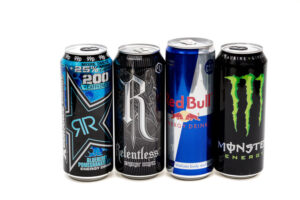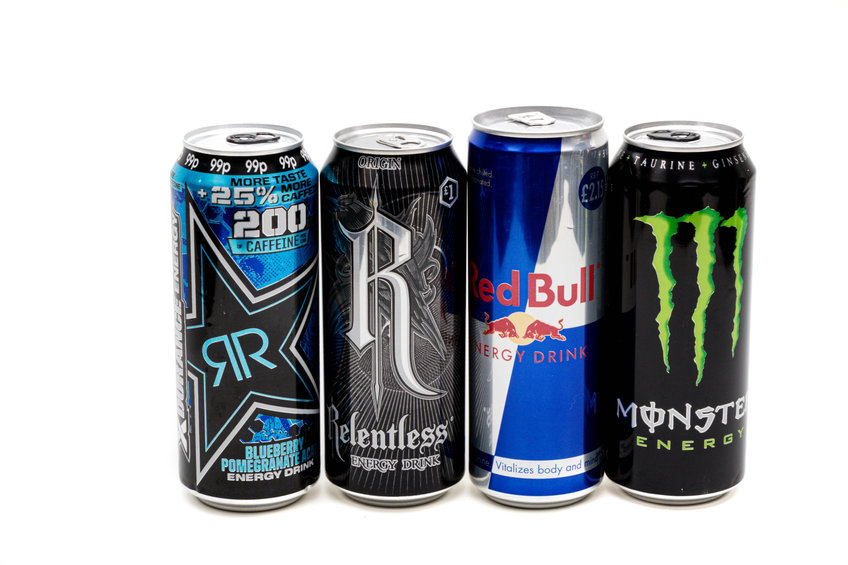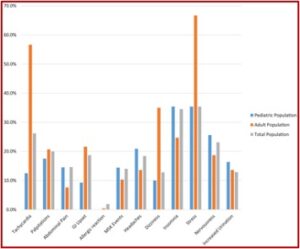
Energy drinks have become a common sight almost where ever you go. Your local convenience store will feature a display of two Monsters, Rockstars or Red Bulls at a discounted price next to the cash register and counter. Sitting nest to the cash register will be a display rack with 5 Hour Energy shots. Statistica reported that energy drinks accounted for 31% of packaged beverage drink sales sold at U.S. convenience stores. Overall, energy drink sales in the U.S. neared $14 billion in 2021. Global energy drink sales reached $57.4 billion in 2020.
History of Energy Drinks
Coca-Cola was developed as a nausea and heartburn tonic, but came with an added extract from coca leaves and caffeine-filled kola nuts to boost energy. Succumbing to government pressure, the company modified its recipe to be cocaine-free in 1929. The first modern energy drink was Lipovitan, created by the Japanese company, Taisho in 1962. It looked, smelled and tasted like cough syrup. Not surprisingly, it didn’t catch on.
The modern enthusiasm for energy drinks began in Thailand in 1976, when a pharmacist invented Krating Daeng, which translates as “Red Bull.” In 1984 an Austrian marketing exec drank a bottle of Red Bull to help with his jet lag. Afterwards he contacted the pharmacist in hope of them teaming up to market it. They added more sugar and caffeine, switched from bottles to cans in an effort to appeal to Europeans, and Red Bull energy drink was created in 1987. A decade later, it came to America.
By the beginning of the 2000s, energy drinks are everywhere. Brands start popping up left and right, and everyone has a preference. In 2001, Rockstar is introduced, followed by Monster Energy in 2002, Pimp Juice by Nelly in 2003, Pit It in 2004. The latter two drinks weren’t very popular, so there’s a good chance you haven’t heard of them. The same year Rip It was introduced, a former monk in India decided to throw his hat in the energy drink ring after seeing the potential for a new kind of boost. He took all the things that give you energy in an energy drink but put them into a tiny, more concentrated shot form, calling it 5 Hour Energy. The shot is a huge success with truckers, who don’t want to drink a lot and stop to pee often but need to stay awake.
Red Bull was the bestselling brand of energy drink in 2021, at $3.26 billion. No surprise, Monster was the second leading energy drink that year with $3.24 billion in sales. Bang Energy was third, at $1.20 billion. 5 Hour Energy sales were $824.5 million. Sales of energy drinks have been growing at a rate of around 5% every year since 2013.
Adverse Effects with Energy Drinks
While they are the fastest growing product in the beverage industry, there has been growing concern about the adverse effects of energy drinks. By 2015, there had been several reports showing adverse effects. “Energy Drink Consumption: Beneficial and Adverse Health Effects” concluded while there may be beneficial effects from energy drinks, there was also evidence of detrimental health consequences. The reported adverse effects were with the cardiovascular system, ischemic stroke and contributing to epileptic seizures. High sugar content could increase the risk of obesity and type 2 diabetes with high energy drink intake.
A Swedish study showed a strong relationship between dental erosion and energy drinks. An American study showed similar results in American children. “Energy drink consumption was associated with about a 2.4-fold increase in dental erosion.” Low pH and high sugar levels of energy drinks are the likely causes.
In “Energy Drinks and Their Adverse Health Effects,” Nadeem et al did a systematic review of 32 studies to evaluate the reported adverse effects. “Only clinical studies reporting adverse events after energy drink consumption were included.” Frequent adverse events with children included insomnia (35.4%), stress (35.4%) and depressed mood (23.1%).
With adults, frequently reported adverse events were insomnia (24.7%), jitteriness/shaking hands (29.8%), and gastrointestinal upset (21.6%). The odds of insomnia and jitteriness were significantly increased with energy drink consumption. When alcohol was mixed with energy drinks, it significantly reduced the sedation effects of the alcohol, “but increased the likelihood of stimulatory effects.” See the following chart from the study:
The authors recommended that individuals avoid frequent energy drink consumption (5-7 energy drinks per week) and avoid co-consumption with alcohol. They suggested increased regulatory standards with the sale of energy drinks, particularly with regard to children.
The National Institutes of Health and the CDC reported a number of safety concerns when consuming energy drinks, beginning with the amount of caffeine. This is accomplished with a hidden-in-plain sight ingredient commonly included in energy drinks called guarana, which has one of the highest concentrations of caffeine in any plant. It may contain up to 3.6% to 5.8% caffeine by weight. Coffee only has up to 2%. So, the addition of guarana increases an energy drink’s total caffeine content.
There are a number of concerns when combining energy drinks with alcohol. It worsens your ability to tell how intoxicated you are. Yet your motor coordination and reaction time may be just as impaired. Drinkers who mix alcohol and energy drinks are also more likely to report unwanted or unprotected sex, driving drunk or riding with someone who is intoxicated.
Drinkers aged 15 to 23 who mix alcohol with energy drinks are four times more likely to binge drink at high intensity (i.e., consume six or more drinks per binge episode) than drinkers who do not mix alcohol with energy drinks.
Between 2007 and 2011 the number of energy drink-related emergency department (ED) visits doubled. “In 2011, 1 in 10 of these visits resulted in hospitalization.” Around 25% of college students consume alcohol with energy drinks; and they binge-drink more often than students who don’t mix alcohol with energy drinks. 42% of all ED visits related to energy drinks involved combining them with alcohol or other drugs (i.e., marijuana, prescription or over-the-counter medicines). The bottom line for the NIH was that “a growing body of scientific evidence shows that energy drinks can have serious health effects, particularly in children, teenagers, and young adults.”
Concern that increased energy drink consumption poses a public health danger, led a team of researchers from the World Health Organization Regional Office for Europe to review the literature of published health risks, consequences and policies with energy drinks. They were concerned particularly with the potential adverse effects on young people. “As energy drink sales are rarely regulated by age, unlike alcohol and tobacco, and there is a proven potential negative effect on children, there is the potential for a significant public health problem in the future.” They gave several suggestions to minimize the potential for harm from energy drinks:
- Establishing an upper limit for the amount of caffeine allowed in a single serving of this type of drinks in line with available scientific evidence;
- Regulations to enforce restriction of labelling and sales of energy drinks to children and adolescents;
- Enforcing standards for responsible marketing to young people by the energy drink industry;
- Training health care practitioners to be aware of the risks and symptoms of energy drinks consumption;
- Patients with a history of diet problems and substance abuse, both alone and combined with alcohol, should be screened for the heavy consumption of energy drinks;
- Educating the public about the risks of mixing alcohol with energy drinks consumption;
- Further research on the potential adverse effects of energy drinks, particularly on young people.
Calls for FDA Energy Drink Regulation
Despite the growing consensus and concern with the adverse effects of energy drinks, the industry has been successful in blocking FDA regulation. Lawyers and Settlements.com reported that members of Congress, consumer watch dog groups and federal health officials have been calling on the FDA to modify the rules and regulations governing energy drinks without any change. One of the difficulties is with how the manufacturer categorizes their product.
Manufacturers can decide on their own whether to call their energy drinks beverages or dietary supplements. 5-Hour Energy, Monster and Rockstar are marketed as dietary supplements. Red Bull is marketed as a conventional food. They also don’t need to disclose how much caffeine their drinks contain. “There are different sets of rules for what can be added and what must be disclosed on the label.”
Producers of energy drinks are not required under current federal regulations to disclose caffeine amounts. The FDA reports there are no limits on the amount of caffeine that dietary supplements can contain, whereas over-the-counter stimulant medications are regulated by the FDA as to how much caffeine they can contain, and so are soft drink manufacturers.The FDA stipulates that soft drinks contain no more than 71.5 mg of caffeine per 12 oz drink, but it cannot regulate the caffeine content in energy drinks – with the exception of energy drink companies that self- classify their products as a dietary supplement, such as Monster and Rockstar.
Law practices willing to see if they can get energy drink manufacturers to pay out on wrongful death claims, or as Red Bull GmbH, the beverage’s Austrian parent company did, pay $640,000 for making false claims about their products usefulness. Despite the claims of “numerous scientific studies” showing the ability of energy drinks to improve energy and performance, the truth is they are no more effective than caffeine or other caffeine-containing products.






